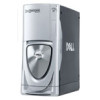Dell XPS /Dimension Gen 5 Owner's Manual - Page 129
System Setup Options, System, Drives, Onboard Devices
 |
View all Dell XPS /Dimension Gen 5 manuals
Add to My Manuals
Save this manual to your list of manuals |
Page 129 highlights
System Setup Options NOTE: Depending on your computer and installed devices, the items listed in this section may not appear, or may not appear exactly as listed. System System Info CPU Info Memory Info PCI Info Date/Time Boot Sequence Drives Diskette Drive Drives 0 through 5 SATA Operation Smart Reporting Onboard Devices Integrated NIC USB Controller 1394 Controller Lists system information such as the computer name, the BIOS version number and date, system tags, and other system-specific information. Identifies whether the computer's processor supports Hyper-Threading and lists the processor bus speed, processor ID, clock speed, and L2 cache. Indicates amount of installed memory, memory speed, channel mode (dual or single), and type of memory installed. Indicates the expansion card type by slot location. Displays current date and time settings. The computer attempts to boot from the sequence of devices specified in this list. NOTE: If you insert a boot device and restart the computer, this option appears in the system setup menu. To boot from a USB memory device, select the USB device and move it so it becomes the first device in the list. Identifies and defines the floppy drive attached to the DSKT connector on the system board as Off, USB, Internal, or Read Only. Identifies the drives attached to the SATA or PRI IDE connectors on the system board, and lists the capacity for hard drives. Identifies and defines the SATA controller settings for RAID. You can set the SATA controller to RAID Autodetect/AHCI, RAID Autodetect/ATA, or RAID On. Determines whether hard-drive errors for internal drives are reported during system startup. Off does not report errors. On reports errors. Enables or disables the integrated NIC controller. Off disables the controller. On enables the controller. NOTE: PXE and RPL is required only if you are booting to an operating system on another system; not if you are booting to an operating system on a hard drive in this system. (Default On) Enables or disables the internal USB controller. Off disables the controller. On enables the controller. No Boot enables the controller but disables the ability to boot from a USB device. Enables or disables the IEEE 1394 controller. Appendix 129















